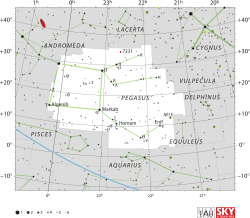Gamma Pegasi

| |
| Observation data Epoch J2000 Equinox J2000 | |
|---|---|
| Constellation | Pegasus |
| Right ascension | 00h 13m 14.15123s[1] |
| Declination | +15° 11′ 00.9368″[1] |
| Apparent magnitude (V) | +2.84[2] |
| Characteristics | |
| Spectral type | B2 IV[3] |
| U−B color index | –0.85[2] |
| B−V color index | –0.23[2] |
| Variable type | β Cep[4] |
| Astrometry | |
| Radial velocity (Rv) | +4.1[5] km/s |
| Proper motion (μ) | RA: +1.98[1] mas/yr Dec.: –9.28[1] mas/yr |
| Parallax (π) | 8.33 ± 0.53[1] mas |
| Distance | 390 ± 20 ly (120 ± 8 pc) |
| Details | |
| Mass | 8.9 ± 0.1[3] M☉ |
| Radius | 4.80 ± 0.39[6] R☉ |
| Luminosity | 5,840[7] L☉ |
| Surface gravity (log g) | 3.98 ± 0.06[6] cgs |
| Temperature | 21,179 ± 237[6] K |
| Metallicity [Fe/H] | –0.34[8] dex |
| Rotational velocity (v sin i) | 0[9] km/s |
| Age | 18.7 ± 3.2[3] Myr |
| Other designations | |
Gamma Pegasi (γ Peg) is a star in the constellation of Pegasus, located at the southwest corner of the asterism known as the Great Square. It also has the traditional name Algenib; confusingly however, this name is also used for Alpha Persei. The average apparent visual magnitude of +2.84[2] puts this at fourth place among the brightest stars in the constellation. The distance to this star has been measured using the parallax technique, yielding a value of roughly 390 light-years (120 parsecs) with a margin of error of 5%.[1]
The asterism of γ Pegasi and α Andromedae, in Hindu astronomy, is called Uttara Bhādrapadā (उत्तरभाद्रपदा) or Uttṛṭṭāti. It is the 26th nakshatra. In Chinese, 壁宿 (Bìxiù), meaning Wall (asterism) refers to an asterism consisting of γ Pegasi and α Andromedae .[11] Consequently, γ Pegasi itself is known as 壁宿一 (Bìxiù yī, English: the First Star of Wall.)[12]
In 1911, American astronomer Keivin Burns discovered that the radial velocity of this star varied slightly. This was confirmed in 1953 by American astronomer D. Harold McNamara, who identified it as a Beta Cephei variable.[4] (At the time he actually identified it as a Beta Canis Majoris star, which was subsequently designated a Beta Cephei variable.)[13] It has a radial pulsation period of 0.15175 days (3.642 hours), but also shows the behavior of a slowly pulsating B star (SPB) with three additional pulsational frequencies.[4] Its magnitude varies between +2.78 and +2.89 over the course of each pulsation cycle.
This is a large star with almost nine[3] times the mass of the Sun and close to five[6] times the Sun's radius. The stellar classification of B2 IV[3] suggests this is a subgiant star that is exhausting the hydrogen at its core and is in the process of evolving away from the main sequence. It is either rotating very slowly with no measurable rotational velocity or else it is being viewed from nearly pole-on.[9] Gamma Pegasi has a total luminosity of 5,840 times that of the Sun,[7] which is being radiated from its outer atmosphere at an effective temperature of more than 21,000 K.[6] At this temperature, the star glows with a blue-white hue.[14]
References
- ↑ 1.0 1.1 1.2 1.3 1.4 1.5 van Leeuwen, F. (November 2007), "Validation of the new Hipparcos reduction", Astronomy and Astrophysics 474 (2): 653–664, arXiv:0708.1752, Bibcode:2007A&A...474..653V, doi:10.1051/0004-6361:20078357
- ↑ 2.0 2.1 2.2 2.3 Crawford, D. L.; Barnes, J. V.; Golson, J. C. (1971), "Four-color, H-beta, and UBV photometry for bright B-type stars in the northern hemisphere", The Astronomical Journal 76: 1058, Bibcode:1971AJ.....76.1058C, doi:10.1086/111220
- ↑ 3.0 3.1 3.2 3.3 3.4 Tetzlaff, N.; Neuhäuser, R.; Hohle, M. M. (January 2011), "A catalogue of young runaway Hipparcos stars within 3 kpc from the Sun", Monthly Notices of the Royal Astronomical Society 410 (1): 190–200, arXiv:1007.4883, Bibcode:2011MNRAS.410..190T, doi:10.1111/j.1365-2966.2010.17434.x
- ↑ 4.0 4.1 4.2 Walczak, P.; Daszyńska-Daszkiewicz, J. (December 2010), "Complex asteroseismology of the hybrid B-type pulsator γ Pegasi: A test of stellar opacities", Astronomische Nachrichten 331 (9/10): 1057–1060, arXiv:1004.2366, Bibcode:2010AN....331.1057W, doi:10.1002/asna.201011456
- ↑ Wilson, Ralph Elmer (1953), General Catalogue of Stellar Radial Velocities, Washington: Carnegie Institution of Washington, Bibcode:1953QB901.W495.....
- ↑ 6.0 6.1 6.2 6.3 6.4 Fitzpatrick, E. L.; Massa, D. (March 2005), "Determining the Physical Properties of the B Stars. II. Calibration of Synthetic Photometry", The Astronomical Journal 129 (3): 1642–1662, arXiv:astro-ph/0412542, Bibcode:2005AJ....129.1642F, doi:10.1086/427855
- ↑ 7.0 7.1 Hohle, M. M.; Neuhäuser, R.; Schutz, B. F. (April 2010), "Masses and luminosities of O- and B-type stars and red supergiants", Astronomische Nachrichten 331 (4): 349, arXiv:1003.2335, Bibcode:2010AN....331..349H, doi:10.1002/asna.200911355
- ↑ Gies, Douglas R.; Lambert, David L. (March 10, 1992), "Carbon, nitrogen, and oxygen abundances in early B-type stars", Astrophysical Journal, Part 1 387: 673–700, Bibcode:1992ApJ...387..673G, doi:10.1086/171116
- ↑ 9.0 9.1 Abt, Helmut A.; Levato, Hugo; Grosso, Monica (July 2002), "Rotational Velocities of B Stars", The Astrophysical Journal 573 (1): 359–365, Bibcode:2002ApJ...573..359A, doi:10.1086/340590. The zero value is for v sin i, so v and/or i must be small.
- ↑ "gam Peg -- Variable Star of beta Cep type", SIMBAD Astronomical Object Database (Centre de Données astronomiques de Strasbourg), retrieved 2012-02-23
- ↑ (Chinese) p. 170, 中國星座神話, written by 陳久金. Published by 台灣書房出版有限公司, 2005, ISBN 978-986-7332-25-7.
- ↑ (Chinese) 香港太空館 - 研究資源 - 亮星中英對照表, Hong Kong Space Museum. Accessed on line November 23, 2010.
- ↑ McNamara, D. H. (June 1953), "Gamma Pegasi: A Beta Canis Majoris Star of Small Velocity Amplitude", Publications of the Astronomical Society of the Pacific 65 (384): 144, Bibcode:1953PASP...65..144M, doi:10.1086/126561
- ↑ "The Colour of Stars", Australia Telescope, Outreach and Education (Commonwealth Scientific and Industrial Research Organisation), December 21, 2004, retrieved 2012-01-16
External links
- Kaler, James B., "ALGENIB (Gamma Pegasi)", Stars (University of Illinois), retrieved 2012-02-24
| ||||||||||||||||||||||||||||||||||